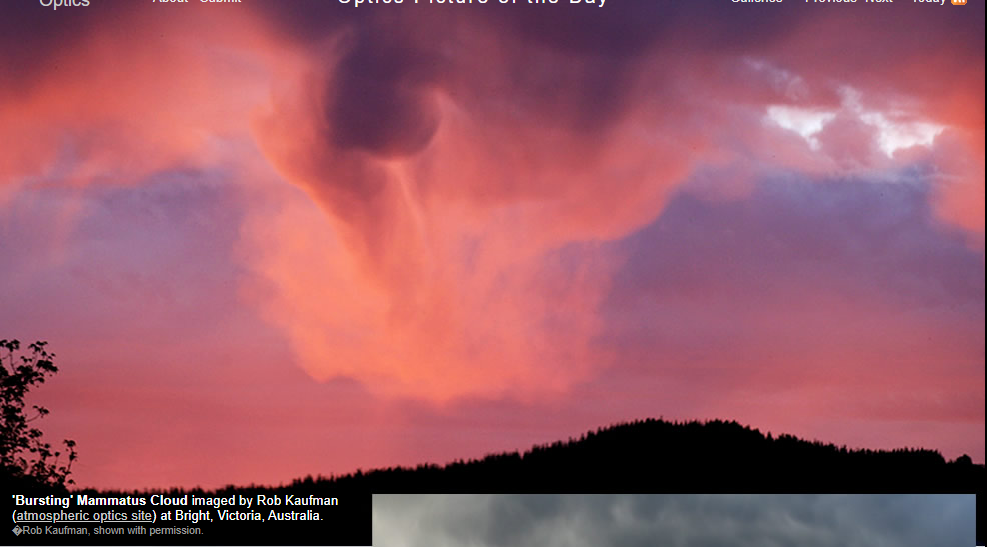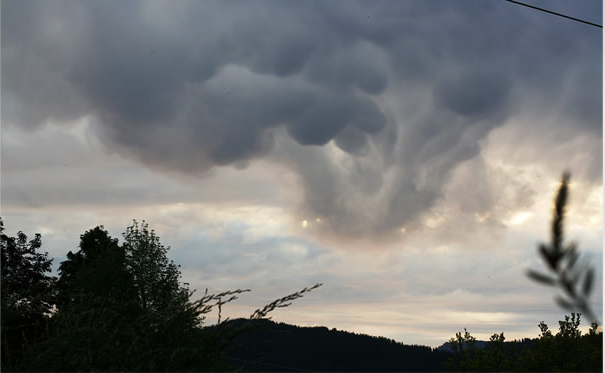Bursting Mammatus Cloud
Bursting Mammatus Cloud: A Phenomenon of Wonder and Mystery
Mammatus clouds, with their distinct pouch-like appearance, have fascinated sky watchers for centuries. These unique cloud formations are commonly observed on the underside of a cumulonimbus anvil following a thunderstorm. However, they can also occur in other cloud types such as cirrus, altocumulus, and stratus clouds, and can even extend from the towering ash clouds of volcanoes. One particularly intriguing variation of mammatus clouds is the phenomenon known as "bursting" mammatus clouds, where some of the pouches appear to burst into shafts of virga, falling rain or ice. In this article, we delve deeper into the enigmatic world of bursting mammatus clouds and explore the various theories surrounding their formation.
One prevailing theory suggests that bursting mammatus clouds may result from the subsidence of the anvil, which creates downdrafts of cold, moist air. As this air descends, it cools and forms the distinctive hanging mammatus cloud structures. However, while this explanation accounts for many sightings, it does not encompass all observed features of bursting mammatus clouds. Consequently, several alternative mechanisms have been proposed to shed light on this captivating phenomenon.
Another hypothesis proposes that the formation of bursting mammatus clouds is linked to the presence of ice crystals, snow, or water droplets within the cloud base. As these particles fall from the cloud, they undergo processes of sublimation (in the case of crystals) or evaporation (in the case of droplets). The resulting cooling effect contributes to the development of the hanging mammatus structures. While this explanation provides valuable insights, it also fails to explain every aspect of bursting mammatus clouds.
The intricate nature of bursting mammatus clouds has led researchers to acknowledge that there might not be a single, definitive process at play. Instead, multiple factors and interactions within the atmosphere could contribute to their formation. The scientific community embraces the mysteries encountered in atmospheric phenomena, as they provide valuable opportunities for further exploration and understanding.
To gain a comprehensive understanding of bursting mammatus clouds, it is crucial to consider their occurrence in different cloud types. While cumulonimbus clouds are the most well-known hosts for mammatus formations, the fact that they can also manifest in cirrus, altocumulus, and stratus clouds expands the realm of possibilities for their formation. Furthermore, the protrusion of mammatus structures from volcanic ash clouds adds another layer of complexity to this captivating atmospheric display.
Capturing the beauty of bursting mammatus clouds through photography has played a significant role in documenting and studying these elusive formations. The striking visual contrast between the dark pouches and the vibrant sunset colors makes for breathtaking imagery. Photographers like Rob Kaufman have dedicated their time and effort to observing and capturing these mesmerizing displays, contributing to our collective knowledge of bursting mammatus clouds.
While bursting mammatus clouds have been observed and photographed on numerous occasions, they remain shrouded in mystery. Despite the advancements in meteorological research, there is still much to learn about their precise formation and behavior. The study of atmospheric optics continually evolves as scientists strive to unravel the secrets held within these awe-inspiring natural phenomena.
In conclusion, bursting mammatus clouds represent a captivating subset of mammatus formations that leave scientists and sky enthusiasts in awe. The theories surrounding their formation encompass factors such as anvil subsidence, ice crystal dynamics, and evaporation processes. However, no single explanation accounts for all observed features, suggesting that multiple mechanisms may be at play. The occurrence of bursting mammatus clouds in various cloud types and even volcanic ash clouds further adds to their intrigue. As we continue to explore the mysteries of atmospheric optics, bursting mammatus clouds stand as a testament to the wonders and complexities of our natural world.

‘Bursting' Mammatus Cloud imaged by Rob Kaufman (atmospheric optics site) at Bright, Victoria, Australia. �Rob Kaufman, shown with permission.


Rob watched the mammatus clouds for 45 minutes as they moved slowly over hills to the west and eventually picked up sunset colours.
Some of the mammatus pouches appear to be bursting into shafts of virga, falling rain or ice. Expert Ken Sassen of University of Alaska comments that mammatus are typically somewhat removed from the active parts of a thunder anvil and that this behaviour must be very unusual.
Mammatus, so named from their pouchy breast like appearance, are mostly seen on the underside of a cumulonimbus anvil after a thunderstorm. Less well known is that they can also occur in cirrus, altocumulus and stratus cloud. They can even protrude down from the towering ash clouds of volcanoes.
Although much photographed, they are much less understood. A common theory is that they result from subsidence of the anvil which gives downdrafts of cold moist air.
Another explanation is that ice crystals, snow or water drops fall from the cloud base and begin to sublime (crystals) or evaporate (droplets). The resulting cooling produces the hanging mammatus cloud.
These explanations do not account for all sightings or features and there are several other proposed mechanisms for the cloud formation. Of course, there might not in any case be a unique process operating.
Mysteries in science are healthy and helpful.

Note: this article has been automatically converted from the old site and may not appear as intended. You can find the original article here.
Reference Atmospheric Optics
If you use any of the definitions, information, or data presented on Atmospheric Optics, please copy the link or reference below to properly credit us as the reference source. Thank you!
-
<a href="https://atoptics.co.uk/blog/bursting-mammatus-cloud/">Bursting Mammatus Cloud</a>
-
"Bursting Mammatus Cloud". Atmospheric Optics. Accessed on December 24, 2024. https://atoptics.co.uk/blog/bursting-mammatus-cloud/.
-
"Bursting Mammatus Cloud". Atmospheric Optics, https://atoptics.co.uk/blog/bursting-mammatus-cloud/. Accessed 24 December, 2024
-
Bursting Mammatus Cloud. Atmospheric Optics. Retrieved from https://atoptics.co.uk/blog/bursting-mammatus-cloud/.